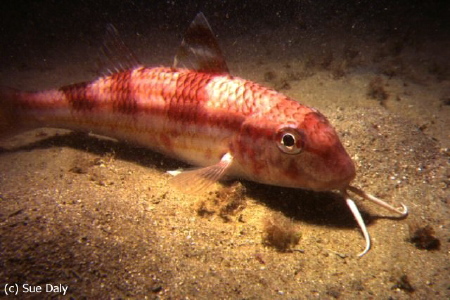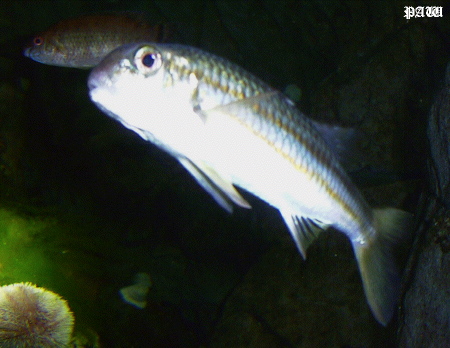Identification:
Elongated body with lateral compression. The snout is blunt and steep, with
two long mobile barbels present on the chin of the lower jaw, and that maybe
folded back into a grove on the underside of the fish. The upper jaw lacks
teeth, and the cheeks have two rows of scales, above the low set mouth. The
eyes are located in the top third of the head. The tail fin is deeply forked.
Two dorsal fins present. The anterior dorsal fin has severn or eight membrane
bound flexible spines, that are separate from the second dorsal fin, which
is composed of one spine and severn to eight branched soft rays. The anal
fin is very similar in shape to the second dorsal fin. The large scales of
the head and body are easily detached and lost.
Considerable changes in colouration occur depending upon the situation, such
as the time of day, stress, condition of the fish, etc. The norm is that
of a pink or reddish colour, with three or four yellow stripes running lengthwise
along the sides, with a reddish brown stripe marking the lateral line. The
belly is pale to white. Brown and yellow banding is to be seen on the anterior
dorsal fin, and to a slight extent upon the second as well. The yellow
banding of the sides tends to become mottled during the hours of darkness,
and more overall yellow hue is taken on by the body.
Breeding:
Spawns over May through into July, with juveniles
being surface feeders until they migrate down to the seafloor.
Habitat:
This bottom dwelling fish is to be found over sands and muds in small shoals,
and favours inshore waters during the summer months, although it is not uncommon
in rocky areas.
Food:
Uses it's barbels to search and locate benthic invertebrates such as crustaceans,
worms, and molluscs, along with the occasional small fish.
Range:
Found throughout UK
waters.
Additional Notes:
Mullus barbatus may, or may not be a separate species, but is
rarer, and one of it's chief characteristics is that it lacks the yellow
bands of Mullus surmuletus and only grows to about 30cm or so.It is
to be found offshore, has shorter barbels, and occurs only rarely in the
SW waters of the UK. |

